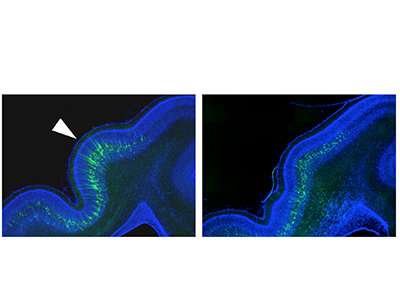Folding of the cerebral cortex—identification of important neurons

Folds in the cerebral cortex in mammals are believed to be indispensable for higher brain functions, but the mechanisms underlying cortical folding remain unknown. By using the latest genome editing tools, researchers have discovered neurons important for fold formation and the importance of the Cdk5 gene in those neurons. Lissencephaly is a condition in which cortical fold formation is impaired. The study may provide clues to diseases including lissencephaly.
The human brain is highly developed and higher functioning compared to other animals. One of the important factors contributing to the development of the brain is the gyrus, the fold on the cerebral cortex surface. The cerebral cortex of higher animals, including humans, has many folds, called gyri. By acquiring these folds in the process of evolution, the human brain developed a larger number of neurons, and thus great development of brain functions. On the other hand, the mouse, a widely used model animal, has a brain without gyri. This has made it very difficult to do research on the gyrus using the mouse as a model animal, which has inhibited research efforts.
The current study used ferrets, which have gyri similar to the human brain (Figure 1). The research group developed a technique for ferrets reported in several articles that allows analysis of ferrets at the genome level. By using this technique, the researchers developed a ferret disease model that shows impairment in the gyrus, which significantly contributes to new genetic approaches to the brains of higher mammals.

Results
By using the latest genome editing tool, a type of genetic engineering, the researchers knocked out a specific gene in the ferret cerebral cortex and elucidated one of the mechanisms of gyrus formation. They combined CRISPR/Cas9, the latest genome editing tool, to introduce a gene into the ferret cerebral cortex. This new technique opens a way to a new stage of genetics research of the brain of higher mammals.

This procedure knocked out a gene called Cdk5 in the ferret cerebral cortex and which resulted in impaired gyrus formation (Figure 2). This result indicates that Cdk5 is an important gene for gyrus formation. The researchers then searched for neurons playing important roles in gyrus formation and found that neurons on the upper-layer cerebral cortex were essential (Figure 3). These results indicate that functions of Cdk5 in neurons of the upper-layer cerebral cortex are important for the formation of the gyrus (Figure 3).
It is expected that this study will advance knowledge of human brain evolution, which was previously quite difficult using a mouse model. Additionally, humans can develop rare diseases due to gyrus impairment, the pathogenesis of which is largely unknown. The new technique could elucidate the etiology of such diseases.
More information: Yohei Shinmyo et al, Folding of the Cerebral Cortex Requires Cdk5 in Upper-Layer Neurons in Gyrencephalic Mammals, Cell Reports (2017). DOI: 10.1016/j.celrep.2017.08.024


















